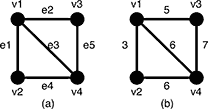今天中午,我终于把准备了一个星期的这道题AC了!
美中不足的是,由于没有删掉freopen,我TM贡献了一次WA...
所以,我们应该要做到吾日N省吾程序:
数组够大乎?
头文件没有错误乎?
freopen删掉乎?
...
先让我小小地得瑟一下,毕竟一直都很想A掉这题,为了这题,我学习了并查集,Kruskal,map(大雾),然后终于把这道题AC掉了,这告诉我们,做一道题也是能学到很多东西的...
Slim Span
Time Limit: 5000MS Memory Limit: 65536K Total Submissions: 7242 Accepted: 3841 Description
Given an undirected weighted graph G, you should find one of spanning trees specified as follows.
The graph G is an ordered pair (V, E), where V is a set of vertices {v1, v2, …, vn} and E is a set of undirected edges {e1, e2, …, em}. Each edge e ∈ E has its weight w(e).
A spanning tree T is a tree (a connected subgraph without cycles) which connects all the n vertices with n − 1 edges. The slimness of a spanning tree T is defined as the difference between the largest weight and the smallest weight among the n − 1 edges of T.
Figure 5: A graph G and the weights of the edgesFor example, a graph G in Figure 5(a) has four vertices {v1, v2, v3, v4} and five undirected edges {e1, e2, e3, e4, e5}. The weights of the edges are w(e1) = 3, w(e2) = 5, w(e3) = 6, w(e4) = 6, w(e5) = 7 as shown in Figure 5(b).
Figure 6: Examples of the spanning trees of GThere are several spanning trees for G. Four of them are depicted in Figure 6(a)~(d). The spanning tree Ta in Figure 6(a) has three edges whose weights are 3, 6 and 7. The largest weight is 7 and the smallest weight is 3 so that the slimness of the tree Ta is 4. The slimnesses of spanning trees Tb, Tc and Td shown in Figure 6(b), (c) and (d) are 3, 2 and 1, respectively. You can easily see the slimness of any other spanning tree is greater than or equal to 1, thus the spanning tree Td in Figure 6(d) is one of the slimmest spanning trees whose slimness is 1.
Your job is to write a program that computes the smallest slimness.
Input
The input consists of multiple datasets, followed by a line containing two zeros separated by a space. Each dataset has the following format.
n m a1 b1 w1 ⋮ am bm wm Every input item in a dataset is a non-negative integer. Items in a line are separated by a space. n is the number of the vertices and m the number of the edges. You can assume 2 ≤ n ≤ 100 and 0 ≤ m ≤ n(n − 1)/2. ak andbk (k = 1, …, m) are positive integers less than or equal to n, which represent the two vertices vak and vbk connected by the kth edge ek. wk is a positive integer less than or equal to 10000, which indicates the weight ofek. You can assume that the graph G = (V, E) is simple, that is, there are no self-loops (that connect the same vertex) nor parallel edges (that are two or more edges whose both ends are the same two vertices).
Output
For each dataset, if the graph has spanning trees, the smallest slimness among them should be printed. Otherwise, −1 should be printed. An output should not contain extra characters.
Sample Input
4 5 1 2 3 1 3 5 1 4 6 2 4 6 3 4 7 4 6 1 2 10 1 3 100 1 4 90 2 3 20 2 4 80 3 4 40 2 1 1 2 1 3 0 3 1 1 2 1 3 3 1 2 2 2 3 5 1 3 6 5 10 1 2 110 1 3 120 1 4 130 1 5 120 2 3 110 2 4 120 2 5 130 3 4 120 3 5 110 4 5 120 5 10 1 2 9384 1 3 887 1 4 2778 1 5 6916 2 3 7794 2 4 8336 2 5 5387 3 4 493 3 5 6650 4 5 1422 5 8 1 2 1 2 3 100 3 4 100 4 5 100 1 5 50 2 5 50 3 5 50 4 1 150 0 0Sample Output
1 20 0 -1 -1 1 0 1686 50Source
Source Code
Problem:3522 User:aclolicon Memory: 784K Time: 297MS Language: G++ Result:Accepted
- Source Code
#include<cstdio> #include<iostream> #include<algorithm> #define INF 0x77ffffff using namespace std; struct edge{ int x, y, v; }e[10005]; int ecnt; int f[105]; int n, m, k; bool cmp(edge x, edge y){ return x.v < y.v; } int find(int x){ if (f[x] != x) f[x] = find(f[x]); return f[x]; } void restore(){ for (int i = 0; i < 105; i++){ f[i] = i; } } void solve(){ sort(e,e+m,cmp); // cout << e[4].v << endl; int slim = INF; for (int mj = 0; mj < m; mj++){ int cnt = 0; int minv = INF, maxv = -1; minv = e[mj].v; for (int i = mj; i < m; i++){ int a = e[i].x, b = e[i].y, c = e[i].v; int x = find(a), y = find(b); // cout << "cmp" << (int)(x == y) << ':' << a << ':' << b << ':' << x << ':' << y << endl; if (x == y) continue; f[x] = y; cnt++; // cout << i << endl; maxv = c; if (cnt == n-1) break; } // cout << cnt << 'd' << endl; restore(); if (cnt != n-1) continue; slim = min(slim, maxv - minv); // cout << slim << ':' << minv << ',' << maxv << endl; } if (slim == INF){ cout << -1 << endl; return; } cout << slim << endl; } void init(){ restore(); ecnt = -1; int x, y, z; for (int i = 0; i < m; i++){ ecnt++; cin >> x >> y >> z; e[ecnt].x = x; e[ecnt].y = y; e[ecnt].v = z; } solve(); } int main(){ // freopen("c.in","r",stdin); while(1){ cin >> n >> m; if (n == 0 && n == 0) return 0; init(); } }
那么我就继续向下一题发起进攻了!




Comments
(Participate in the discussion)
Comments
No comments found.
No comments found.